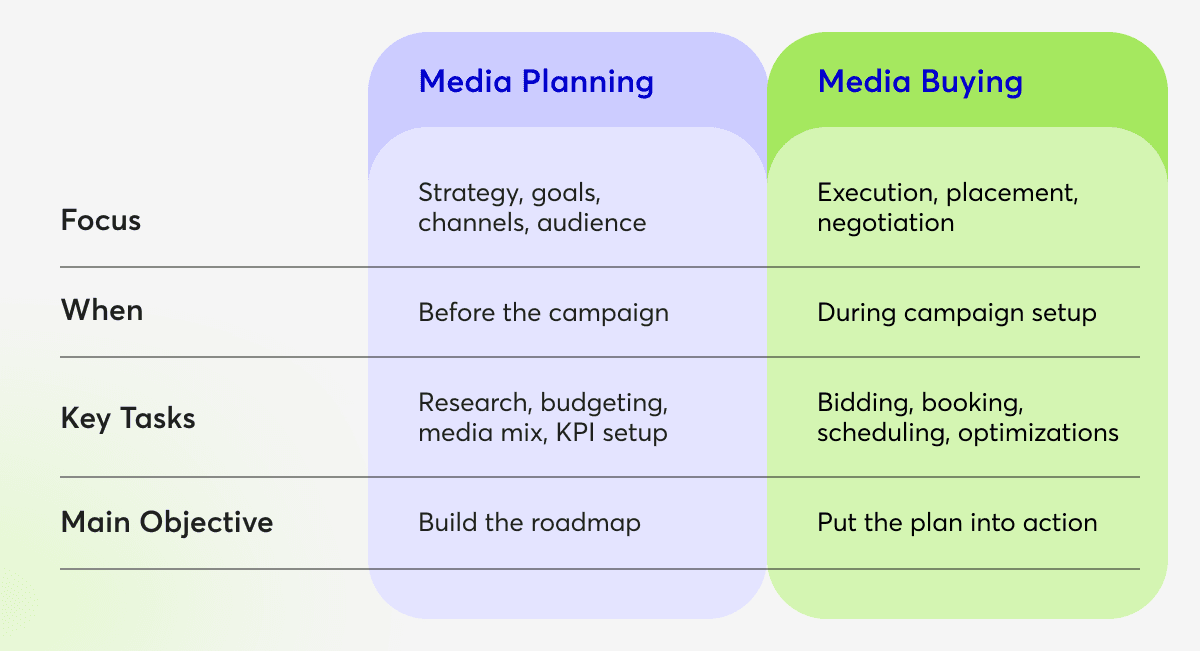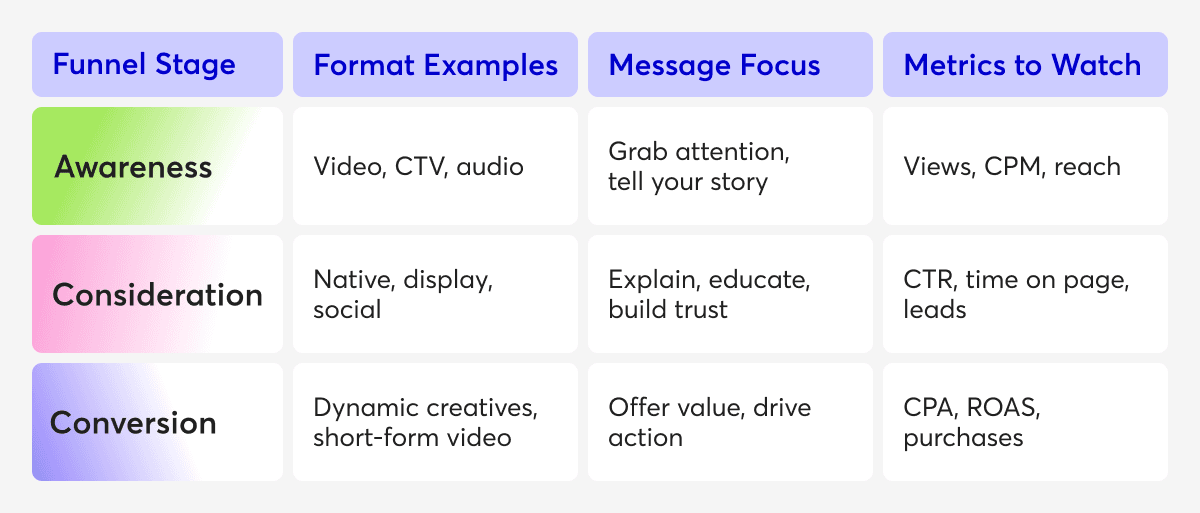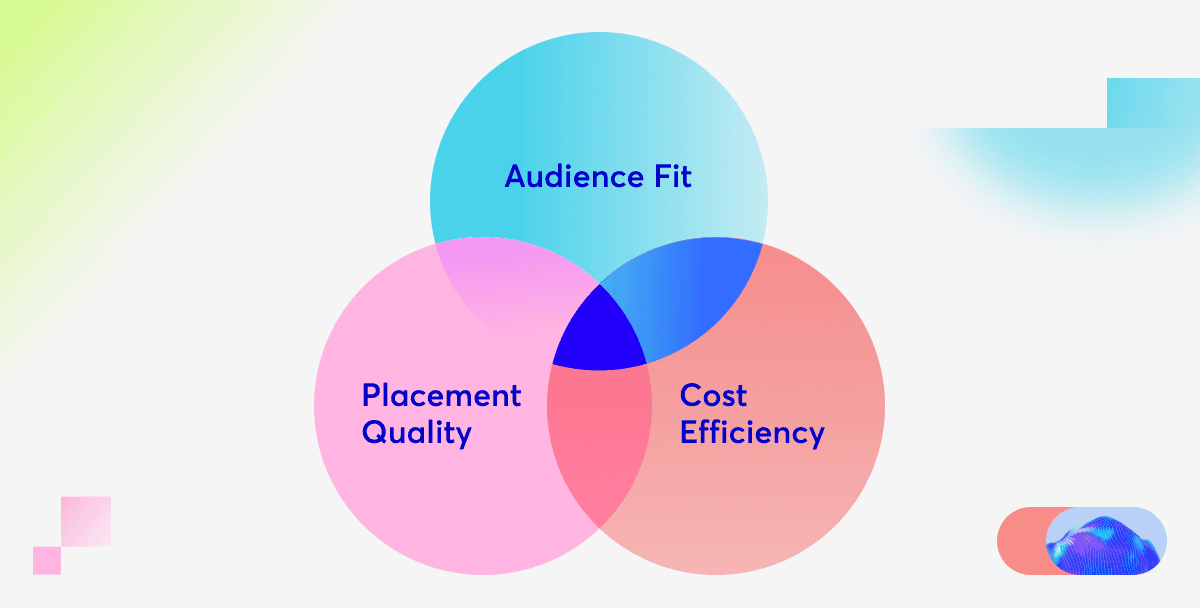Smart media buying isn’t just about spending — it’s about strategy. This step-by-step guide breaks down how to plan, buy and optimize ad placements that actually move the needle. Learn how to turn your budget into real results.
A Media Buying Glossary
- RTB (Real-Time Bidding) - Instant auctions for ad space that happen as a page loads
- CPC (Cost Per Click) - You pay only when someone clicks your ad
- CPA (Cost Per Action) - Cost for a specific result — like a lead or a sale
- CPM (Cost Per Mille) - Cost per 1,000 impressions — ideal for reach-focused campaigns
- ROAS (Return on Ad Spend) - Revenue earned for every dollar spent on ads
- CTV (Connected TV) - Ads on smart TVs and streaming platforms
- CTR (Click-Through Rate) - Percentage of people who clicked after seeing your ad
- CSR (Corporate Social Responsibility) - A brand’s commitment to ethical and sustainable practices
Media Buying: An Introduction
Not too long ago, media buying was as simple as calling up a publisher and locking in a flat rate. Fast forward to today, and it’s a whole new playing field. From real-time bidding to AI-driven targeting, the process has become smarter, faster and way more competitive. But in this environment, “buying wisely” always beats “buying cheap.” It’s not about grabbing space — it’s about capturing value.
This guide unpacks the evolution of media buying — from traditional direct buys to dynamic programmatic auctions — and gives you the tools to navigate it all. Whether you're optimizing spend, boosting reach or learning how to buy ad space without burning your budget, you’re in the right place.
What is Media Buying?
Imagine this: your brand shows up right where your audience is already looking — mid-scroll on a trusted news site or mid-video on their favorite app. That’s media buying in action. Media buying goes beyond paying for ad space: it’s knowing where your message will actually matter.
Smart media buying and planning is part strategy, part timing and part knowing your audience better than your competition does. When done right, media buying is a power move: one that puts your brand in front of people who are ready to notice.
Media Buying Vs. Media Planning
If media buying is the moment you hit “go,” then media planning is everything that happens before it. Media planning is where strategy lives: setting goals, choosing channels, defining budgets and sketching out what success should look like. Media buying, on the other hand, is where action happens: negotiating prices, securing placements and launching the actual campaigns.
You can’t have one without the other. Great results come from great coordination between these roles. While planners map the route, buyers make sure the ride is smooth, targeted and cost-effective. That’s why media planning and buying are often managed together; although they require different skills, they work best as a package.

Buying Ad Space: The Different Ways You Can Do It
Let’s be honest, media buying isn’t some monolithic thing. There are a few ways to get your ads out there, and what works for one brand might not work for another. It all depends on what you need: control, speed, scale — or maybe a bit of all three.
Direct Buying
Direct buying may be a bit old-school, but it’s still relevant today. With direct, you reach out to the publisher, agree on the terms and your ad goes live exactly where you intended. It’s a solid choice when you need control over placement; however, it usually requires more time and some careful back-and-forth to get right.
Programmatic Buying
This one’s for the multitaskers. Programmatic buying is simple: you set the rules, the platform does the rest. Your ads show up where they make the most sense, without you clicking through endless sites. It’s fast, data-smart and scalable — what’s not to like?
Real-Time Bidding (RTB)
RTB is basically programmatic with rocket fuel. Every ad slot is auctioned off in real time, right when someone opens a page. It’s quick and dynamic; additionally, it’s great for volume, but you’ve got to keep an eye on performance.
From Plan to Placement: How Media Buying Really Works
Showing up isn’t enough. Today’s media landscape demands precision. In this media buying guide, we will walk you through each stage of the process, helping you plan with purpose, buy with clarity and align every move with measurable impact.
Step 1: Define Your Goals and Clarify KPIs
Before you spend a dollar, you need to know what you're trying to achieve — and “more clicks” isn’t a strategy. Are you aiming for reach? Conversions? Brand lift? Your campaign goals will shape everything that follows from where you buy, to how you measure success.
Awareness and Performance Aren’t the Same Thing Want to make noise or drive action? That’s the first real question. Awareness campaigns aim to get your name out there, so you’re looking at reach, viewability and maybe CPM. But if you need results you can tie to revenue, then clicks, conversions and ROAS are your focus. Mixing the two can blur your focus and eat up budget fast.
Set KPIs That Actually Mean Something It’s not enough to say “we want results.” Translate business objectives into specific, measurable media benchmarks. Define what success looks like before launch, whether it’s a $3 CPC, a $20 CPA or a minimum 3x ROAS. That’s the only way to build a successful online media buying strategy that can scale and improve over time.
Step 2: Audience Research and Media Planning Basics
Advertising doesn’t work in a vacuum. If you’re not speaking to the right people (in the right format, at the right time) even the most polished ad will fall flat. That’s why media planning starts with one thing: knowing who you’re really talking to.
Start with questions, not platforms. Who is your ideal customer? Where do they spend time online? What content are they engaging with? A sharp understanding of your audience will shape your targeting, messaging and channel choices. Once you have that knowledge, you can begin to and lay the groundwork for smarter media planning and buying decisions.
From there, build your plan around attention, not just impressions. The best media plans don't chase numbers — they match context with intent. Knowing that your audience hangs out on mobile, reads niche news sites or skips video ads after five seconds? That's an insight worth budgeting around.
Step 3: Choosing the Right Ad Channels and Formats
The channel you choose can make or break your message. That’s why understanding the media mix is essential to any effective campaign. But don’t fall for picking the flashiest format! Choose the one that best fits.
Let’s break it down:
- Display is everywhere. It’s good for reach, but not always for action.
- Video builds emotion and story and is great for mid-funnel.
- Audio is intimate but limited in visuals.
- Native blends into content, making it a solid performer across stages.
- CTV delivers on attention, especially in lean-back environments.
- Out-of-Home (OOH) still wins for frequency and location-based impact.
Each channel serves a different purpose. The smartest brands use them together, not in silos. A short pre-roll video might spark interest, while a native ad nurtures it, and a display retargeting unit brings it home. That’s how a cohesive funnel works. This isn’t just channel selection — it’s orchestration. And that’s what separates average campaigns from those built on real strategy, like in any solid media planning and buying beginners guide.
Step 4: Planning the Campaign Strategy
Once you’ve nailed down your goals and know who you’re targeting, it’s time to connect the dots. Campaign strategy is where planning meets execution. The goal here is to build a flow that supports your objectives across the entire funnel.
Think through the journey:
- At the top, you might lead with bold video or CTV to drive awareness.
- In the middle, retarget with native or display ads that educate or compare.
- Closer to conversion, consider dynamic creatives or promos tailored for action.
Map out which channels speak to each stage, what message they should carry and how you’ll measure success. A good media buying and planning strategy not only reaches people but also moves them.

Step 5: Buying the Right Ad Placements
This is the moment things get real. You’ve planned, budgeted and mapped your funnel, and now it’s time to place your ads where they’ll actually make an impact.
Whether you’re running programmatic or negotiating directly, remember: not all impressions are created equal. A sidebar banner on a finance blog might outperform a homepage takeover on a general news site — simply because it hits the right person at the right time. Knowing how to buy ad space effectively means balancing price, visibility, and context — not just going for the biggest splash.

Step 6: Launch, Track, Adjust. Repeat.
Even the most thought-out campaign is just theory until it goes live. Once your ads are up, the real work begins: tracking. Don’t wait for the end of the flight to check results. In fact, early signals often tell you whether you're on the right track or burning money.
Our advice? Set up tracking before launch, not after. Make sure pixels, UTMs and attribution tools are working from day one. Then monitor key performance indicators in real time: CPC, CTR, CPA, ROAS — whatever matters most for your goal. But don’t obsess over every dip. What you want is to find patterns, not panic.
A strong media buying strategy always leaves room to iterate. If something isn’t working, adjust creative, tweak bidding or shift budgets. Optimization is the pulse of digital advertising, and the brands that win are the ones that keep listening and keep tweaking.
MGID: More Than Traffic — A Strategic Media Partner
Media buying can get messy fast, especially when you're juggling creatives, placements and performance goals. That’s where MGID comes in. With MGID, we help shape the whole journey. From building funnels that convert to developing the kind of creatives people actually want to click, MGID gives advertisers tools and hands-on support to keep things moving in the right direction.
Working with MGID means you’re not left figuring things out on your own. Our team of experts helps you at every stage, from strategy and setup to testing and scaling. You don’t need a copywriter, a designer or a developer on standby. We’ll help build and launch ready-to-go campaigns that are optimized from day one. And with access to a high-quality, performance-focused audience, you’re not just getting traffic — you’re getting the right traffic.
Avoiding Common Media-Buying Pitfalls
Even the best campaigns can fall apart if you don’t watch for the usual traps. We’ll discuss some of the most common mistakes and how to sidestep them before they drain your budget or your patience.
Pitfall: Chasing volume over value More impressions don’t always mean better results. It’s easy to fall for cheap CPMs, until you realize those impressions aren't converting.
Fix: Prioritize placements with real audience alignment. Quality over quantity wins every time in smart media planning and buying.
Pitfall: Setting it and forgetting it Launching a campaign and walking away is a recipe for missed opportunities — or worse, wasted spend.
Fix: Set up a cadence for review. Check performance every few days early on. Small tweaks early save big costs later.
Pitfall: Ignoring creative fatigue Even top-performing creatives hit a wall. Audiences tune out. Performance tanks.
Fix: Rotate creatives regularly. Test new visuals, formats and copy before fatigue kicks in. Better yet, let tools do the heavy lifting. Tools like CTR Guard by MGID track drops in viewable CTR and flag fatigue before your results take a hit. You’ll get smart alerts and AI-generated creatives you can deploy with a single click. That way, you stay ahead without second-guessing.
Pitfall: Tracking too little — or too much Measuring the wrong metrics (or all of them at once) clouds your decision-making.
Fix: Focus on KPIs tied directly to your goals. One campaign = one clear success metric.
What’s Next in Media Buying: 5 Trends You Can’t Ignore
Media buying isn’t standing still, so neither should your strategy. As the digital ecosystem shifts, smart advertisers are already adapting to what’s next. Here are five trends worth watching (and preparing for), especially if you want your media buying strategy to stay relevant beyond the next quarter.
AI-Powered Planning Gets Sharper
We’re past the hype stage. AI is now quietly reshaping how campaigns are built, from bid strategies that adjust in real time to predictive planning that maps out audience intent before you even hit launch.
Context Is King Again
As third-party cookies phase out, advertisers are starting to rethink how they reach people. Signal loss across platforms is pushing the industry back toward contextual targeting, but this time, it’s more advanced. It’s not just about matching keywords: it’s about understanding sentiment, content patterns and intent signals in real time.
Retail Media and First-Party Data Rise Up
Amazon started the wave, but now every major retailer wants in. These networks offer deep consumer insight, high-converting placements and something every buyer craves: clean first-party data.
Sustainability Joins the Strategy Deck
Advertisers are beginning to factor in carbon emissions and eco-friendly delivery into their media plans. Sustainability is no longer a CSR side note but a KPI.
Video Everywhere — and Gaming Too
CTV is still hot, but mobile gaming is quietly pulling massive ad dollars thanks to time-spent and high engagement. If your media plan doesn’t include either, it’s time for a rethink.
Wrapping It Up
Media buying is like dancing to a rhythm. The more time you spend inside that rhythm — testing, adjusting, learning — the more natural it gets. You don’t have to nail every move. What’s important is knowing when to pivot and why it matters.
At the end of the day, great campaigns are built on alignment, not guesswork. Align your goals, your audience, your message and the moment you show up. Because if you get that right, media buying turns from a task into a competitive edge.





